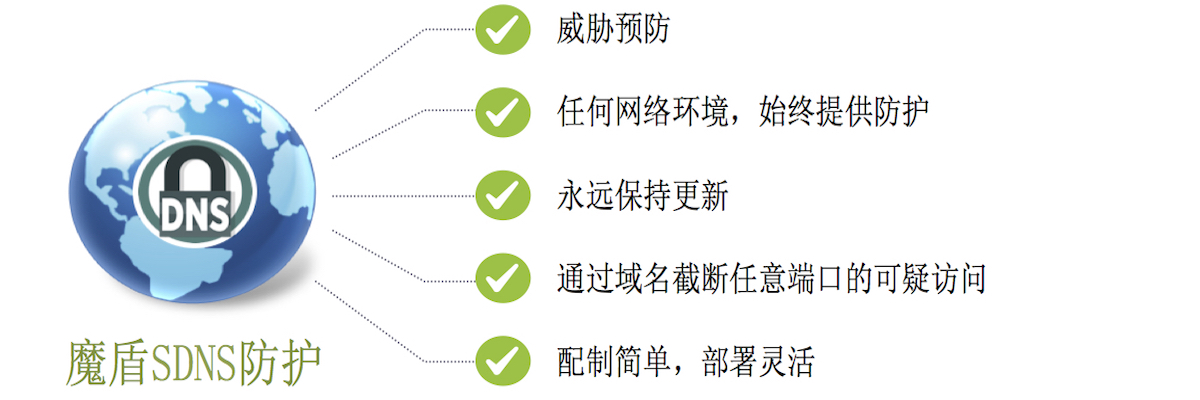终端设备网络安全解决方案
独特的DNS层网络安全解决方案,轻松实现网络安全与控制

企业网络安全现状
50% 的终端设备为移动设备;70% 的办公室直连互联网。到2018年,25% 的企业网络流量将绕过企业传统安全部署。 企业安全正在从硬件产品向云服务转移,因此云交付的安全服务,灵活覆盖终端的安全服务将至关重要。
通常安装“新”的安全防护设备到企业网络架构或终端设备就意味着增加延迟,增加网络复杂度,消耗内存,和造成用户工作干扰。 如何简化安全部署?如何摆脱被动的威胁检测?如何将攻击者的网络部署信息和针对攻击者的威胁情报信息 (服务器地址,IP,域名等)快速应用到未知威胁防护当中?坦诚的说,没有安全产品可以检测和防御所有威胁, 如何以更小的代价覆盖更大的防御范围?如何加强安全产品间的联动性及如何增强自身的威胁情报挖掘能力?
魔盾SDNS工作原理
DNS是互联网的基础架构,将我们容易记忆的网址域名与不容易记忆的IP地址做自动解析。 所有联网设备都需要使用DNS解析,无论您的网络架构如何,局域网或广域网,DNS永远在工作。
魔盾SDNS以智能分析和情报为基础,在网络出入口建立安全防护。在帮助用户进行DNS解析的同时实现安全防御。 不增加DNS解析延迟,也不影响企业已有的安全策略;配置简单,无需维护与更新。
魔盾SDNS拦截恶意链接访问,阻挡恶意指令回拨,记录DNS解析日志,管理DNS解析策略。 您还可以在DNS报告中了解威胁趋势,挖掘威胁情报。
魔盾SDNS的优势
- 适用任何使用场景,用最简单的方式实现安全。
- DNS层的安全防护,不增加延迟,降低复杂度。
- 部署简单,使用方便,无需维护与更新。
- 适合灵活的网络架构,适用于移动设备与物联网(IoT)设备,并可集成至内网管理。
- 域名解析大数据与基于域名解析的策略管理,威胁情报搜索与挖掘。

魔盾SDNS防护
不仅是简单静态的黑名单,不仅工作于80/443端口,无论流量是否经过企业网络安全设备,都可以实现威胁检测与威胁防御。

魔盾SDNS管理
掌握解析请求和威胁阻截纪录;图表式大数据分析;可自定义黑白名单与网站类别访问策略,支持基于内网用户的策略设置。

魔盾SDNS情报
一站式深度威胁情报挖掘;了解全局DNS解析趋势与全球域名威胁信息;掌控针对域名及IP的威胁情报,强化安全策略。